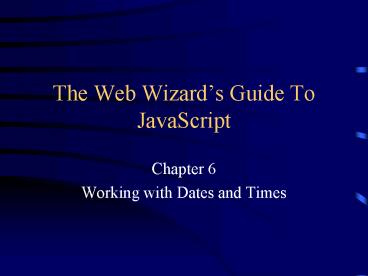The Web Wizards Guide To JavaScript - PowerPoint PPT Presentation
Title:
The Web Wizards Guide To JavaScript
Description:
function showTime(){ /* Callout: A new Date() object is created and ... body bgcolor='white' onload='setInterval('showTime()',1000);' div align='CENTER' ... – PowerPoint PPT presentation
Number of Views:55
Avg rating:3.0/5.0
Title: The Web Wizards Guide To JavaScript
1
The Web Wizards Guide To JavaScript
- Chapter 6
- Working with Dates and Times
2
Chapter Objectives
- To understand JavaScripts Date object
- To learn how to add a clock to a Web page
- To find out how to display the time and date in
any format you like - To see how to add a greeting to a Web page that
changes with the time of day - To learn how to add a time-sensitive greeting to
your Web page clock - To discover how to perform calculations based on
dates
3
The Date Object
- JavaScript contains a set of core objects,
including the Date object, that exist
independently of any host environment such as a
Web browser. - To use the Date object, you first create an
instance of it and then apply a method to obtain
date and time information. - Var currentDate new Date()
4
Methods for the Date Object
- getDate()
- getDay()
- getFullYear()
- getHours()
- getMilliseconds()
- getMinutes()
- getMonth()
- getSeconds()
- getTime()
- getYear()
- toLocaleString()
5
Creating a simple clock
- lthtmlgtltheadgtlttitlegtBasic Clocklt/titlegt
- ltscript type"text/javascript" language"JavaScrip
t"gt - lt!--
- function showTime()
- / Callout A new Date() object is created and
stored in a variable. / - var now new Date()
- / Callout the toLocaleString() method of
the Date object converts the date to a text
format used in the visitor's location. / - document.clock.face.value
now.toLocaleString() - //--gt
- lt/scriptgt
- lt/headgt
- lt!-- Callout The setInterval() method causes the
clock to be updated every second.--gt - ltbody bgcolor"white" onload"setInterval('showTim
e()',1000)"gt - ltdiv align"CENTER"gt
- lth1gtA Very Basic JavaScript Clocklt/h1gt
- ltform name"clock"gtltinput name"face"
size"50"gtlt/formgt - lt/divgt
6
Creating a Better Clock
- To create customized presentations of the time,
you obtain the current hour, minute, and seconds
using methods of the Date object. - These values can be stored as variables and then
concatenated (joined together) to create a string
of text to express the time.
7
Creating Dynamic Greetings
- It is possible to vary the information displayed
on your Web page according to the time or date. - If code exists in the HEAD to test for the time
of day, you can create variable content in the
BODY using the document.write() method.
8
Text Fields vs. document.write()
- Use document.write() for content that will not
change during the visitors session. - Use text fields for content that requires
updating during the visitors session, such as
time of day.
9
Date Mathematics
- JavaScripts Math object is a built-in
calculator. - To perform math operations on information
obtained from text fields, you first convert the
values to numbers using the parseInt() or
parseFloat() function. - Date mathematics allows you to create countdown
pages to important events.
10
Differences in the two objects
- Date Object an instance is created of it by
creation in code - var currentDate new Date()
- Math object Static, which means that we never
creates an instance of the object - Math.abs (x), Math.floor(x), Math.max(x,y)
- Math.min(x,y), Math.random()

